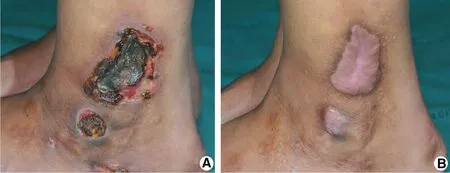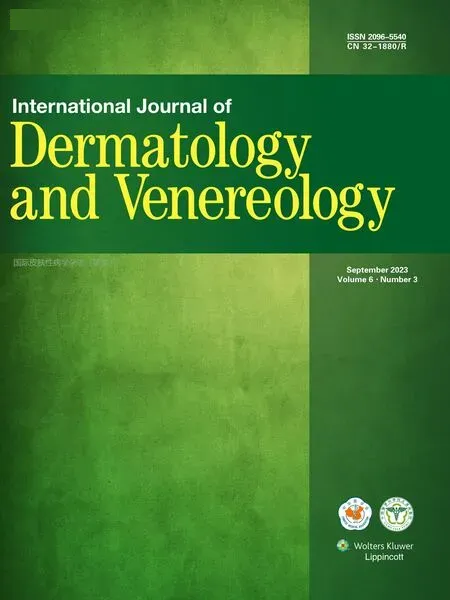Livedoid Vasculopathy Secondary to Protein C Deficiency: A Case Successfully Treated With Rivaroxaban
Nattanicha Chaisrimaneepan* and Tanongkiet Tienthavorn
1 Institute of Dermatology, Ministry of Public Health, Bangkok 10400, Thailand; 2 Division of Dermatosurgery, Institute of Dermatology, Department of Medical Services, Ministry of Public Health, Bangkok 10400, Thailand.
Abstract
Keywords: livedoid vasculopathy, protein C deficiency, rivaroxaban, hypercoagulability, hypercoagulable state,atrophie blanche
lntroduction
Livedoid vasculopathy (LV) is a thrombo-occlusive disease of the dermal microcirculation leading to ischemia and infarction and predisposing to infection.1Its etiology is mainly a hypercoagulable state, which can be either acquired or inherited.The disease course is chronic,1and recurrences and episodic exacerbations are not unusual.2Cases of LV secondary to protein C deficiency have been periodically reported with different successful treatment regimens.We herein report a case of recurrent leg ulcers due to LV with protein C deficiency that was successfully treated with rivaroxaban.
Case report
A 31-year-old Thai woman was diagnosed with LV proven by skin biopsy 10 years previously.Laboratory investigations at the time of the first diagnosis included a complete blood count; urinalysis; hepatitis virus profile;cryoglobulin and cryofibrinogen levels; and antinuclear antibody, anticardiolipin, protein C, and protein S activity.All results were unremarkable.She had been treated with aspirin, pentoxifylline, and colchicine.The doses had been adjusted according to the severity of her waxing and waning leg ulcers during the past 10 years, but clinical remission had never been achieved.

Figure 1.Clinical features of a patient with livedoid vasculopathy secondary to protein C deficiency.(A) The multiple punched-out ulcers with oozing serum and hemorrhagic crusts on the medial and lateral sides of both ankles.(B) The ulcers resolved with hypertrophic scars after 16-week treatment.
On her regular follow-up visit, she complained of worsening painful leg ulcers for 2 months despite her excellent compliance with treatment.She denied underlying diseases,smoking, and history of abortion.Physical examination revealed multiple punched-out ulcers with oozing serum and hemorrhagic crusts on the medial and lateral sides of both ankles.Scarring was also present on the dorsum of both feet,indicating previously healed ulcers (Fig.1A).The capillary refill time of both lower extremities was normal.The peripheral arterial pulses were intact.The ankle-brachial indices on both sides of the extremities (right side = 1.07, left side =0.9) were within the normal range, and arterial compromise was excluded.Venous Doppler ultrasound showed no evidence of a thrombus in the deep venous system and no insufficiency in the superficial system.A swab wound culture revealed extended-spectrum beta-lactamase-producingEscherichia coliinfection.Several laboratory investigations were performed to reassess the patient for hypercoagulable states considering the lack of success of the past treatment.A complete blood count, liver function test, blood urea nitrogen, creatinine, antinuclear antibody, antiphospholipid panel, and antithrombin and protein S activity were normal.No factor V Leiden mutation was found.However, her protein C activity was significantly low.
She was treated with a 14-day course of intravenous ertapenem for the superimposed bacterial infection.For treatment of the LV, rivaroxaban was initiated at 10 mg daily, replacing aspirin and colchicine, and pentoxifylline was continued at 1,200 mg daily.After 8 weeks of rivaroxaban, the leg ulcers and pain remarkably improved.The dose of pentoxifylline was gradually tapered, and the drug was stopped by week 16, and the ulcers resolved with hypertrophic scars (Fig.1B).No abnormal bleeding was noted while on dual therapy.The patient thereafter continued rivaroxaban monotherapy with no development of new lesions and no adverse effects.
In this case, protein C deficiency was suspected to be the cause of LV.Approximately 16 months follow-up after the patient achieved clinical remission, she underwent a second protein C activity test.Rivaroxaban was stopped 72 hours prior to the test.Her protein C activity was still low, confirming the diagnosis of LV with protein C deficiency in this patient.
Patient consent declaration
The patient gave the written informed consent about this case publication including the clinical imagings.
Discussion
LV is characterized by tender papules as well as purpura or petechia with surrounding telangiectasia distributed over the distal lower legs and ankles and extending to the back of feet.Punched-out ulcers are commonly seen.1
Atrophie blanche (AB), which is often described in patients with LV, presents as porcelain-white atrophic scars with peripheral telangiectasias.It is also found in chronic venous insufficiency and other thrombophilic diseases such as antiphospholipid syndrome.3AB lesions in patients with LV are located on the medial and lateral ankles and extend to the dorsum of the feet, and they may or may not be preceded by ulcers.In contrast, AB lesions in patients with venous insufficiency are located on the medial ankles and are usually preceded by venous ulcers.3Duplex ultrasonography can aid in distinguishing the two entities.4Given the location of the leg ulcers and the normal venous Doppler ultrasonographic findings in our patient, LV was more likely than venous insufficiency.
When LV is suspected, skin biopsy should be performed.Laboratory investigations should exclude fibrinolytic disorders, collagen vascular diseases, infectious associations, paraproteinemia, and hypercoagulable states.5Because of the thrombo-occlusive nature of LV,affected patients should be evaluated for both acquired and inherited hypercoagulable states.2When investigating acquired hypercoagulable states, antiphospholipid antibody panels must be included.6-7Additionally, causes of acquired antithrombin deficiency and acquired protein C and S deficiencies must be excluded.When investigating inherited hypercoagulable states, tests must include factor V Leiden mutation/activated protein C resistance; prothrombin G20210A mutation; the homocysteine level; and protein C, protein S, and antithrombin activity.2
To diagnose a patient with a hypercoagulable state,at least two to three consecutive results of the same test performed at least 12 weeks apart must be positive.6-7Direct oral anticoagulants should be stopped at least 72 hours prior to hypercoagulability tests to avoid false-normal protein C activity.6If stopping anticoagulants is not possible, genetic analysis by DNA sequencing to identify mutations in the protein C-encodingPROCgene can confirm the diagnosis of protein C deficiency.6However,some patients have no identifiable hypercoagulation disorder and are considered to have idiopathic protein C deficiency.5In our case, the diagnosis of protein C deficiency was later confirmed by two consecutive low protein C activity measurement results.
No definite therapeutic guideline for LV has yet been established.1Specific treatment is based on successful case reports and case series.8Therapeutic options in the form of either monotherapy or combined therapy include antiplatelets, anticoagulants, fibrinolytics, anabolic steroids,nutritional supplements, hyperbaric oxygen therapy, and intravenous immunoglobulin.1,5,8However, protein C is a vitamin K-dependent natural anticoagulant, and warfarin should be avoided or cautiously prescribed because of the risk of developing warfarin-induced skin necrosis and worsening skin lesions.7Recent systematic reviews and a phase 2a clinical trial revealed the effectiveness of rivaroxaban, a direct factor Xa inhibitor anticoagulant,in the treatment of LV with few adverse effects.8-10The limitation is that the exact pharmacological effects has been unclear.
Our patient was confirmed to have LV with protein C deficiency.Rivaroxaban was able to resolve the patient’s leg ulcers and maintain clinical remission with no adverse effects.In the authors’ opinion, rivaroxaban can also be combined with an antiplatelet agent in recalcitrant cases,although the clinician should be aware of the bleeding risk.
- 國(guó)際皮膚性病學(xué)雜志的其它文章
- Tuberculosis Verrucosa Cutis on the Buttocks:A Case Report
- Neutrophilic Panniculitis Associated With Myelodysplastic Syndrome/Myeloproliferative Neoplasm: A Case Report and Literature Review
- The Relationship Between Ultraviolet B and DNA Methylation in Skin Cancers
- The Role of Endoplasmic Reticulum Stress in Melanoma
- Basal Cell Carcinoma Excision Guided by Dermoscopy: A Retrospective Study in Macau
- Teledermatology During the COVID-19 Pandemic in a Developing Country: Could This Be the Answer to Improving the Reach of Dermatology Care?

